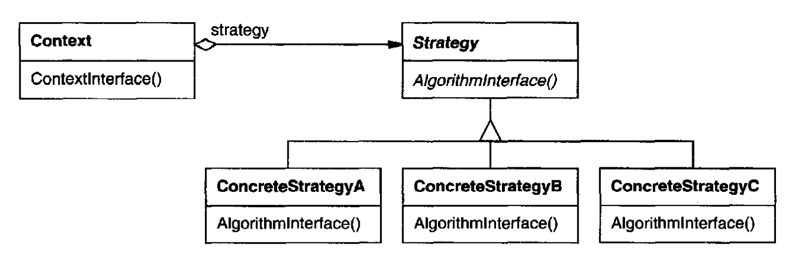전략 패턴은 문제 해결 방법(알고리즘)을 캡슐화하여 클라이언트 코드와 분리함으로써, 알고리즘의 교체를 동적으로 수행할 수 있게 해준다.
Motivation
정렬 알고리즘을 사용하는 프로그램이 있다고 하자. 이 프로그램은 여러 가지 정렬 알고리즘(예: 버블 정렬, 퀵 정렬)을 지원해야 한다. 사용자는 상황에 따라 정렬 알고리즘을 선택할 수 있어야 한다고 하자.
이때 전략 패턴을 사용하면 클라이언트 코드는 정렬 방식에 의존하지 않으며 전략(정렬 알고리즘)을 동적으로 교체할 수 있다.
Applicability
- 행동들이 조금씩 다를 뿐 개념적으로 관련된 많은 클래스들이 존재할 때
- 알고리즘의 변형이 필요할 때
- 사용자가 몰라야 하는 데이터를 사용하는 알고리즘이 있을 때
- 하나의 클래스가 많은 행동을 정의하고, 이런 행동들이 그 클래스 연산 안에서 복잡한 다중 조건문의 모습을 취할 때
Structure

Strategy: 제공하는 모든 알고리즘에 대한 공통의 연산들을 인터페이스로 정의한다.ConcreteStrategy:Strategy인터페이스를 실제 알고리즘으로 구현한다.Context:Strategy객체에 대한 참조자를 관리하고, 실제Strategy서브클래스의 인스턴스를 갖고 있음으로써 구체화된다. 또한Strategy객체가 자료에 접근하는 데 필요한 인터페이스를 제공한다.
Collaborations
- 사용자는
ConcreteStrategy객체를 생성하여Context에 전달한다. - 동일 계열의 여러
ConcreteStrategy클래스가 준비되어 있는 경우, 사용자는 상황이나 필요에 따라 원하는 전략을 선택하고, 그 전략을Context에 설정한다. Context가ConcreteStrategy에 설정되면,Context는 클라이언트의 요청을 해당 전략에 전달해 작업을 처리한다.
Consequences
-
동일 계열의 관련 알고리즘군이 생긴다.
-
서브클래싱을 사용하지 않는 대안이다.
Context클래스를 직접 상속해 행동을 구현하는 방법은 간단할 수 있지만,Context와 알고리즘이 혼합되어 코드가 복잡해지고, 수정과 확장이 어렵다.전략 패턴을 사용해 알고리즘을 별도 클래스로 독립시켜
Context와 분리할 수 있으므로, 알고리즘을 쉽게 변경, 이해 및 확장할 수 있으며, 전체 시스템의 유연성과 유지보수성이 크게 향상된다. -
조건문을 없앨 수 있다.
다음은 전략 패턴을 사용하기 전 코드이다.
void Composition::Repair() { switch (_breakingStrategy) { case SimpleStrategy: ComposeWithSimpleCompositor(); break; case TeXStrategy: ComposeWithTeXCompositor(); break; // ... } // merge results with existing composition, if necessary }전략 패턴을 사용하면
case문을 없앨 수 있다.void Composition::Repair() { _compositor->Compose(); // merge results with existing composition, if necessary } -
구현의 선택이 가능하다.
동일한 행동에 대해 서로 다른 구현을 제공할 수 있다.
-
사용자는 서로 다른 전략을 알아야 한다.
사용자는 전략을 선택하기 전 전략들이 어떻게 다른지 이해해야 한다. 즉, 사용자는 구현 내용을 모두 알아야 한다.
-
Strategy객체와Context객체 사이 의사소통 오버헤드가 있다.ConcreteStrategy클래스는Strategy인터페이스를 공유한다. 따라서 어떤ConcreteStrategy클래스는 이 인터페이스를 통해 들어온 모든 정보를 다 사용하지 않는데도 이 정보를 가져야 할 때도 있다. -
객체 수가 증가한다.
Implementation
-
Strategy및Context인터페이스를 정의한다.전략 패턴 구현 시
Strategy및Context사이 데이터 교환 방식은 유연성과 결합도의 균형에 따라 선택된다.- 매개변수로 전달하는 방식: 결합도를 낮추면서도, 필요 시
Strategy가 충분한 정보를 활용할 수 있다. Context자체 또는 참조를 전달하는 방식:Strategy가 필요한 정보를 직접 요청할 수 있으므로 유연하지만, 결합도가 높아질 수 있다.
어느 쪽을 선택하든
Context는 데이터에 접근할 수 있는 정교한 인터페이스를 제공해야 하며,Strategy객체는 그 인터페이스를 통해 필요한 정보를 정확히 요청할 수 있어야 한다. - 매개변수로 전달하는 방식: 결합도를 낮추면서도, 필요 시
-
전략을 템플릿 매개변수로 사용한다.
C++의 템플릿을 통해 전략을 가진 클래스를 구성할 수 있다. 이 기법은 두 가지 조건이 만족되어야 적용할 수 있다.
Strategy객체를 컴파일 타임에 결정Strategy객체가 런타임에 바꿀 필요가 없을 때
이 조건이 만족한다면 구성할 클래스(
Context)를 템플릿 클래스로 정의하고,Strategy클래스를 이 템플릿의 매개변수로 정의한다. 이 템플릿을 이용하면Strategy인터페이스를 정의하는 추상 클래스를 정의할 필요가 없어진다.template <class AStrategy> class Context { void Operation() { theStrategy.DoAlgorithm(); } // ... private: AStrategy theStrategy; };이렇게 되면
Context클래스는 인스턴스화 시점에Strategy클래스에서 구성된다.class MyStrategy { public: void DoAlgorithm(); }; Context<MyStrategy> aContext; -
Strategy객체에 선택성을 부여한다.Context객체는 필요한 경우에만Strategy객체를 사용하고, 그렇지 않다면Context내부에 미리 정의된 기본 행동(default behavior)을 수행하도록 할 수 있다.
Sample Code
Composition 클래스는 문서 내 포함된 텍스트와 그래픽 컴포넌트를 관리하고, 이를 한 줄로 배열하는 작업을 수행하기 위해 Compositor 객체(전략 객체)를 이용한다. 각 컴포넌트는 자신과 연관된 실제 크게, 신축성(stretchability)와 수축성(shrinkability)를 가지고 있다.
Composition 객체는 값을 Compositor 객체에 보내며, Compositor 객체는 이 값을 사용해 줄 분리에 가장 좋은 위치를 결정한다.
class Composition {
public:
Composition(Compositor*);
void Repair();
private:
Compositor* _compositor;
Component* _components; // the list of components
int _componentCount; // the number of components
int _lineWidth; // the Composition's line width
int* _lineBreaks; // the position of linebreaks
// in components
int _lineCount; // the number of lines
};
새로운 레이아웃이 필요할 때 Composition 클래스는 Compositor에게 라인을 어디서 분리해야 하는지 요청한다. 이때, Compositor 클래스의 Compose() 메서드는 필요한 모든 정보를 매개변수로 받아 처리한 후, 계산된 줄 분리자의 개수를 반환한다.
Compositor 클래스의 인터페이스는 필요한 정보를 매개변수로 전달한다.
class Compositor {
public:
virtual int Compose(Coord natural[],
Coord stretch[],
Coord shrink[],
int componentCount,
int lineWidth,
int breaks[]) = 0;
protected:
Compositor();
};
Compositor의 구체 서브클래스는 특별한 줄 분리 전략을 정의한다.
Repair() 연산은 Composition 클래스에서 문서의 레이아웃을 다시 계산하는 역할을 한다. 이 과정에서 Compositor 객체를 이용해 줄을 어디서 분리할지 결정하고, 그 결과를 이용해 문서의 컴포넌트들을 다시 배치한다.
void Composition::Repair() {
Coord* natural;
Coord* stretchability;
Coord* shrinkability;
int componentCount;
int* breaks;
// prepare the arrays with the desired component sizes
// ...
// determine where the breaks are:
int breakCount;
breakCount = _compositor->Compose(
natural,
stretchability,
shrinkability,
componentCount,
_lineWidth,
breaks
);
// lay out components according to breaks
// ...
}
SimpleCompositor 클래스는 Compositor 클래스를 상속받는 서브클래스로, 가장 단순한 방식으로 줄을 나누는 알고리즘을 구현한다.
class SimpleCompositor : public Compositor {
public:
SimpleCompositor();
virtual int Compose(
Coord natural[],
Coord stretch[],
Coord shrink[],
int componentCount,
int lineWidth,
int breaks[]
);
// ...
};
TeXCompositor는 TeX의 정교한 조판 시스템을 모방해 문단 단위로 텍스트를 정렬한다.
class TeXCompositor : public Compositor {
public:
TeXCompositor();
virtual int Compose(
Coord natural[],
Coord stretch[],
Coord shrink[],
int componentCount,
int lineWidth,
int breaks[]
);
// ...
};
ArrayCompositor는 일정한 간격으로 컴포넌트를 나누어 배치한다.
class ArrayCompositor : public Compositor {
public:
ArrayCompositor(int interval);
virtual int Compose(
Coord natural[],
Coord stretch[],
Coord shrink[],
int componentCount,
int lineWidth,
int breaks[]
);
// ...
};
이 클래스들은 Compose() 연산이 넘겨받은 정보를 다 사용하지 않는다.
마지막으로 Composition 클래스의 인스턴스를 만들려면, 필요한 Compositor 인스턴스를 넘겨주어야 한다.
Composition* quick = new Composition(new SimpleCompositor);
Composition* slick - new Composition(new TeXCompositor);
Composition* iconic = new Composition(new ArrayCompositor(100));